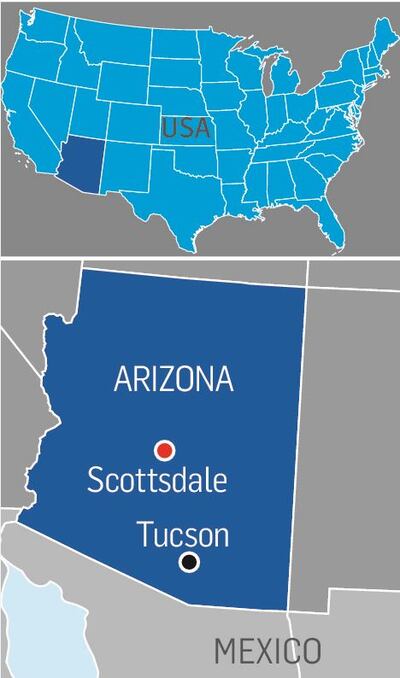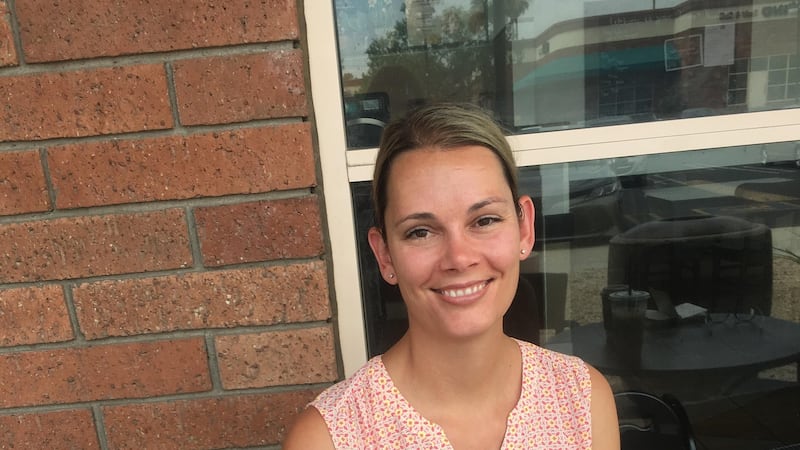
Fifteen kilometres northeast of downtown Phoenix, Arizona's capital, lies the suburb of Scottsdale.
The leafy enclave has long been Republican territory, but Democrats are hopeful that middle-class suburbs such as this are where the battle for control of Congress can be won in November.
On this quiet midday morning, moms in yoga pants stop by for coffee in the Starbucks dotted discretely around the neighbourhood. Sleek SUVs drive around upmarket shopping malls, dropping off teenagers or picking up groceries at the local Whole Food stores.
It’s just after 10am, and local resident Jennifer Samuels is sipping coffee in the sun. The 38-year-old mother of three is an eighth grade teacher at Desert Shadows Middle School in North Scottsdale.

She is also one of the growing number of people who Democrats hope can swing November’s federal and state elections in their favour.
Samuels is running for a seat in Arizona’s state House of Representatives.
Mass walkout
Like many people in this community – and in several states around the country – her engagement in politics was prompted by her involvement in a mass walkout this year that saw teachers across the country rise up against unfair pay and conditions in the education sector.
In April, tens of thousands of teachers across Arizona marched on the state capital in Phoenix demanding a 20 per cent pay rise and an increase in funding for schools.
The #RedforEd movement, as it was termed, resulted in schools across the state shutting for six days.
The mass walkout – one of the biggest public demonstrations in Arizona's history – followed similar walkouts in Oklahoma, West Virginia and Kentucky, and sparked widespread national media attention.
Samuels says the trigger for deciding to strike was watching what happened in West Virginia. “Frustrations had been growing among teachers year after year, but we are a right-to-work state, which means we can’t organise, we can’t strike. When we saw what was going on in West Virginia, I remember going into my neighbour’s classroom and we were thinking the same thing – if they can, we can.”
Social media campaign
A social media campaign took root, beginning with a decision to wear red in the classroom. “Overnight, the Facebook group had thousands of members, it soon grew to 50,000 members, and spread across schools in the Phoenix metro area,” recalls Samuels.
“We needed someone to pave the way for us, we needed the confidence to join forces collectively and West Virginia did that for us.”
Still wary about the legal ramifications of striking, in the weeks running up to the walkouts, schools hosted “walk-ins” whereby parents and other members of the community were invited to meet teachers before the start of the school day, to learn more about why teachers were protesting.

“We needed to have parents’ support. Closing schools is a real inconvenience, so buy-in was important. Many teachers wanted to strike straight away, but we needed to be patient, to build that community support before we walked out.”
What followed was six full days of strikes and demonstrations at the state capital in downtown Phoenix. Approximately 800,000 students were affected statewide, as schools closed across the state, from Flagstaff in the north to Tucson in the south of this sprawling state.
Years of cuts
According to Samuels, teachers and families had had enough of years of low pay and poor funding. Arizona has one of the lowest pay rates for teachers in the country – a trend that campaigners like Samuels puts down to years of cuts by Republican-controlled state legislatures and governorships.
According to the National Education Association, in 2016 Arizona came 43rd in the ranking of 50 states when it comes to teachers’ pay. This was coupled with deep cuts in the state’s budget on education over the past 10 years which has negatively affected class numbers and school facilities.
The association estimates that the average teacher salary is just over $47,000 (€40,000) – about $10,000 less than the national average.
According to Samuels, many teachers are now working second or third jobs to pay the bills. A growing number of teachers, for example, are working as Uber drivers.
“I’m very fortunate that I am married to a husband with a salary that can support us – it’s how I can afford to teach, but many teachers simply do not have enough to make ends meet,” she says.
Success
Like many of the campaigns in states across the country, the Arizona #RedforEd campaign paid off.
After an all-night legislative session, the state legislature passed a new budget package, granting a 20 per cent increase in teacher pay over the next three years, and new funding for support staff, textbooks and upgraded technology and infrastructure.
I think if there is any positive to come from Trump's election it's that people are becoming more engaged
Samuels says that while the new funds are welcome, there is still a $700 million shortfall in spending since 2008 that needs to be met. Among the proposals being put forward by activists is a proposal to tax the top 1 per cent in Arizona. “The state legislature offers tax breaks for large corporations instead of investing in education,” says Samuels. “This can change.”
Like many of the new crop of political activists who are contesting this year’s federal and local elections, Samuels is hoping to capitalise on the political energy that has been unleashed by grassroots movements such as #RedforEd.
Many of the new generation of political candidates are women – for example, Samuels is facing two other female candidates in the Democratic primary contest for her district.
Political movement
Already there are signs that the #RedforEd movement is morphing into a more sustained political movement. The social media campaign which surfaced during the school protests – #RememberNovember – has been attracting attention in recent weeks, a sign that the activism expressed during the April protests may be felt at the polling booths.
The other motivating factor is Donald Trump. Samuels is a lifelong registered Democrat and voted for Hillary Clinton in the 2016 election, though most of her family vote Republican. "I can still vividly remember waking up the morning after the election and literally crying for my three daughters, for the future of my country," she says. "My values are so polar opposite of his."
But she is positive about the future, and believes change is in the offing.
“I think if there is any positive to come from his election it’s that people are becoming more engaged, more people are becoming activists. No one thought that Arizona would ever mobilise, for example. Year after year we just accepted what legislation was passed, when we knew that it wasn’t best for students. It felt like we were powerless, that we had no ability to make a change.”
The past few months have shown the power of resistance and the power of political engagement, she says. “With these coming elections, I think that things will be different.”
Tomorrow: Trump supporters in Kingman, Mohave County, on why they think he will win the White House again in 2020.













